1. Ruppell’s Griffon Vulture Highest Flying Bird– 37,000 feet
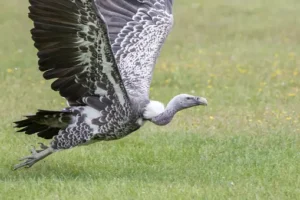
Ruppell’s griffon vulture is the 0ne of top 12 highest flying birds in the world. It is known for its exceptional flight capabilities, including its ability to reach high altitudes. There have been reports and studies suggesting that these vultures can soar to impressive heights, often exceeding 37,000 feet (11,000 meters) above sea level.
One particularly noteworthy incident occurred in 1973 when a Ruppell’s griffon vulture collided with an airplane at an altitude of 37,000 feet over West Africa. This incident was documented and reported in various sources. The collision with the aircraft, which was flying at cruising altitude, provided scientific evidence of the vulture’s remarkable ability to reach such extreme heights.
The vulture’s ability to reach these altitudes is a testament to its powerful flight and soaring capabilities, which are essential for its scavenging lifestyle. Soaring at great heights allows these birds to efficiently locate carrion and other food sources over vast landscapes.
It’s important to note that while Ruppell’s griffon vulture is known for its high-altitude flights, not all individuals or flights will necessarily reach such extreme heights. The ability to reach such altitudes can vary depending on factors such as air currents, weather conditions, and the specific circumstances of each flight.
2. Crane – 33,000 feet
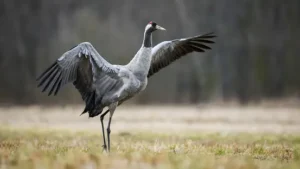
Cranes are not typically associated with extremely high-altitude flights like some vultures, there have been reports of cranes reaching impressive heights during migration. One well-known example is the Siberian crane a critically endangered crane species. During their migratory journeys, Siberian cranes have been reported to fly at altitudes of up to 33,000 feet (10,000 meters) or even higher. These altitudes are remarkable considering the size and physiology of these birds.
Siberian cranes undertake long and arduous migrations between their breeding grounds in Siberia and their wintering areas in India and China. They need to cross several geographic and climatic barriers, including the Himalayas, which necessitates high-altitude flights to avoid these obstacles.
It’s important to note that while some cranes, particularly the Siberian crane, have been documented flying at such heights during migration, not all crane species engage in such behavior. Cranes generally fly at altitudes that are lower than those reported for high-flying vultures or certain other bird species. The altitudes reached by birds during migration can vary based on factors such as weather conditions, wind patterns, and specific flight requirements.
Also See This: Amazing Top 15 birds with long beaks
3. Bar-headed Goose – 29,000 feet

The bar-headed goose is a remarkable bird species known for its high-altitude migratory flights. It is famous for its ability to fly over the Himalayas, one of the world’s highest mountain ranges, during its annual migrations. Bar-headed geese have been recorded flying at altitudes of up to 29,000 feet (8,800 meters) or even higher as they cross the Himalayas. These altitudes are noteworthy because they involve flying over some of the tallest peaks on Earth, including Mount Everest.
Bar-headed geese have specialized physiological adaptations that allow them to cope with low oxygen levels at high altitudes. They have larger lungs and more efficient oxygen transport systems compared to other geese. These geese use a combination of flapping flight and soaring to navigate through the challenging Himalayan terrain.
They take advantage of updrafts and wind currents to reduce energy expenditure during their strenuous flights. During their high-altitude flights, bar-headed geese maintain a relatively slow and steady pace. This helps conserve energy and reduce the demands on their bodies. Bar-headed geese are known to make migratory stops at lower elevations before attempting the challenging Himalayan crossings. This allows them to acclimate to the lower oxygen levels gradually.
4. Whooper Swan – 27,000 feet
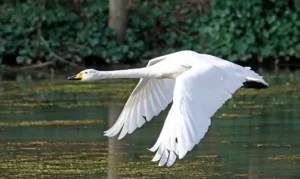
The Whooper Swan is a large waterfowl species known for its distinctive whooping call and impressive migratory behavior. While it is not typically associated with high-altitude flights like some other bird species, there have been reports of Whooper Swans reaching altitudes of up to 27,000 feet (8,200 meters) during their migrations.
During their long migrations between their breeding grounds in northern regions of Europe and Asia and their wintering areas in more temperate regions, some Whooper Swans have been observed flying at altitudes considered higher than those usually associated with waterfowl. These altitudes are still considerably lower than those reported for species like the bar-headed goose or certain vultures, but they are notable for a swan species.
It’s important to recognize that high-altitude flights for waterfowl, including Whooper Swans, are not their typical behavior. Their migrations often involve flying at lower altitudes over land and water bodies. The ability to reach such altitudes during migration can vary based on a variety of factors, including wind patterns, weather conditions, and the specific circumstances of each migration. The Whooper Swan’s migratory behavior and its ability to cover vast distances during migration contribute to its ecological significance and make it a fascinating species for ornithological research.
5. Alpine Chough – 26,500 feet
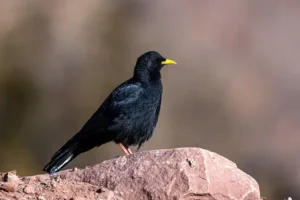
The Alpine Chough is a bird species that is well-known for its ability to thrive in high-altitude mountain environments, including the rocky and alpine regions of Europe and Asia. While not as famous for its high-altitude flights as some other birds like vultures or geese, the Alpine Chough has been observed at impressive altitudes during its flights.
Reports and studies suggest that Alpine Choughs have been observed flying at altitudes of up to 26,500 feet (8,077 meters) or even higher. These altitudes are remarkable given the challenging and often harsh conditions of their mountain habitats.
Alpine Choughs are well-adapted to high-altitude environments, and their flight capabilities allow them to navigate through the rugged terrain and take advantage of wind currents. They are agile and acrobatic fliers, often performing aerial displays and swooping flights in their mountainous habitats.
While the exact altitudes reached by Alpine Choughs can vary, their ability to fly at such heights showcases their remarkable adaptations to life in alpine ecosystems. These adaptations include strong flight muscles, efficient oxygen utilization, and specialized respiratory systems that allow them to thrive in low-oxygen environments.
The behavior and adaptations of the Alpine Chough make it an interesting subject of study for researchers interested in understanding how birds are able to survive and thrive in extreme altitudes and environments.
6. Bearded Vulture – 24,000 feet

It seems like you’ve provided a phrase “Bearded Vulture – 24,000 feet,” but you haven’t provided any context or question to go along with it. The bearded vulture, also known as the Lammergeier, is a fascinating bird found in mountainous regions, particularly in Europe, Asia, and Africa. It’s known for its distinctive appearance, including its dark feathers and bearded appearance around its neck.
The altitude of 24,000 feet is quite high and falls within the range of some of the world’s highest mountain peaks. If you have a specific question or topic you’d like to discuss related to the bearded vulture or its altitude, please provide more details so I can assist you better
7. Mallard – 21,000 feet

It appears that you’re providing another phrase, “Mallard – 21,000 feet,” without additional context or a clear question. The mallard is a common and widely recognized species of duck found throughout North America, Europe, Asia, and other regions.
An altitude of 21,000 feet is quite high and is well above the typical flying altitude of mallards. Mallards are waterfowl that primarily inhabit wetlands, ponds, lakes, and rivers. They are not adapted for high-altitude flying like some other bird species, such as migratory waterfowl or birds of prey.
If you have a specific inquiry or topic in mind related to mallards or their altitude, please provide more details so I can better understand and assist you.
May Be You Like It: 12 Amazing Facts: Black Palm Cockatoo
8. Bar-tailed Godwit – 20,000 feet

The bar-tailed godwit is an altitude of 20,000 feet (approximately 6,096 meters) would be exceptionally high for this species. Bar-tailed godwits are known to undertake some of the longest known nonstop flights of any bird during their migration. They breed in the Arctic regions of North America, Europe, and Asia, and then fly thousands of miles to their wintering grounds in places like Australia and New Zealand. These migrations typically involve altitudes that are much lower than 20,000 feet.
During their nonstop flights, bar-tailed godwits might fly at higher altitudes, but such altitudes are not typical or sustained. These birds are adapted for long-distance flight, but they primarily fly at lower altitudes, skimming over water bodies and coastal areas during their migratory journeys.
9. White Stork – 16,000 feet

The white stork (Ciconia ciconia) is a large bird known for its distinctive appearance and migratory behavior. An altitude of 16,000 feet (approximately 4,877 meters) would be quite high for a white stork.
White storks are migratory birds that breed in Europe and parts of Asia and then migrate to Africa for the winter. During their migrations, they primarily fly at lower altitudes, typically within the range of a few hundred to a couple of thousand feet above the ground. They are not adapted for sustained high-altitude flight like some other bird species.
It’s worth noting that these altitudes are not typical for the flight patterns of white storks. They generally take advantage of thermals and updrafts to conserve energy during their migrations, which usually involve flying at lower elevations where they can easily spot and access their preferred feeding grounds.
10. Andean Condor – 15,000 feet

The Andean condor (Vultur gryphus) is a large vulture species found in South America, particularly in the Andes Mountains. It is one of the world’s largest flying birds and is well-adapted to soaring at high altitudes. So, an altitude of 15,000 feet (approximately 4,572 meters) is well within the capabilities of the Andean condor.
Andean condors are known for their impressive aerial abilities and often soar at great heights to take advantage of updrafts and thermal currents. They have a large wingspan and are well-suited for gliding and soaring for extended periods of time. These birds use their keen eyesight to locate carrion (dead animals) from high altitudes, which is their primary source of food.
Flying at high altitudes allows the Andean condor to efficiently cover large areas in search of food and to move between different habitats. Their ability to navigate mountainous terrain and utilize air currents helps them conserve energy during flight.
11: Greater White Fronted Goose – 20,000 feet

The altitude of 20,000 feet (about 6,096 meters) is exceptionally high for all waterfowl species, including the White-fronted Goose (Anser albifrons). These geese are primarily adapted to low level flight and are not known to fly at such high altitudes.
The White-fronted Goose is a migratory bird that breeds in the arctic regions of North America and Eurasia and then migrates south to more temperate areas for the winter. On their migration, they typically fly at altitudes well below 20,000 feet, often hovering over bodies of water, fields, and other landscapes.
Although these geese fly with strength and skill, they lack the special adaptations for soaring which are evident in some other bird species, such as birds of prey or some long-distance migratory birds. They fly more comfortably and efficiently to lower altitudes where they can easily find and access suitable habitats and food sources.
12: Common Swift – 21,300 feet
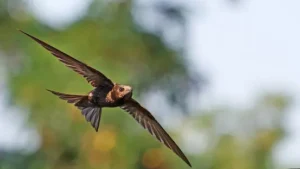
The common swift is a remarkable bird known for its exceptional flying abilities and its ability to spend almost its entire life in the air. An altitude of 21,300 feet (approximately 6,492 meters) is indeed within the known capabilities of the common swift.
Common swifts are highly aerial birds that are often seen flying high in the sky, especially during their migrations. They have long, slender wings and are built for efficient and agile flight. These birds feed on insects, which they catch on the wing, and they often fly at considerable altitudes to access their airborne prey.
During their migrations, common swifts can reach impressive heights as they ride air currents and thermals. They are known to fly at altitudes well above those typically seen in other bird species. These birds are often associated with high-flying behavior and have been observed at altitudes approaching or exceeding 20,000 feet.
It’s important to note that while common swifts can reach such altitudes, their regular flight patterns may vary, and they also spend a significant amount of time flying at lower altitudes to hunt for insects and navigate their environments.
FAQ’s:
What are the highest flying birds in the world?
The highest flying birds in the world are typically species that have adapted to fly at extreme altitudes, often in mountainous or open environments. These birds have specialized adaptations that allow them to soar and navigate at high altitudes.
Which bird holds the record for the highest flight?
The Ruppell’s griffon vulture holds the record for the highest known flight by a bird. It collided with an airplane at an altitude of 37,000 feet (11,278 meters) above sea level.
What adaptations do birds have for high-altitude flight?
Birds that fly at high altitudes have several adaptations to cope with the low oxygen levels and cold temperatures. These adaptations include larger lungs, more efficient circulatory systems, and specialized hemoglobin that can bind more oxygen.
Are all high-flying birds migratory?
No, not all high-flying birds are migratory. While some high-altitude flyers are migratory and use these altitudes during their journeys, others, like certain vulture species, may spend a significant amount of time soaring at high elevations while searching for carrion.
Why do some birds fly at such high altitudes?
Birds fly at high altitudes for various reasons. Migratory birds might use these altitudes to take advantage of wind patterns and thermals, conserving energy during their long journeys. Additionally, some birds of prey use high altitudes for spotting prey, and certain species have adapted to high-altitude environments for their entire lives.
Must Visit: Vetpomedix.com
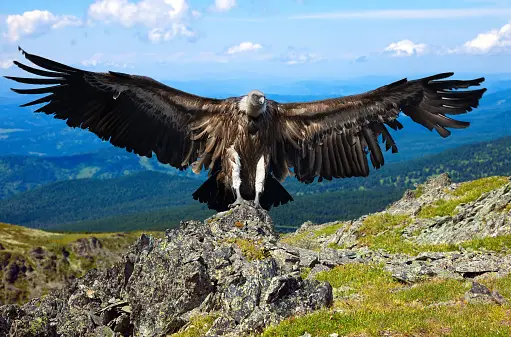


odit eligendi voluptas totam magni minima reiciendis. non laborum at animi omnis atque earum est consequatur voluptatem porro aut ea rerum modi quisquam. saepe quod vel sit voluptatem velit pariatur u
delectus culpa omnis delectus quos provident totam aliquam. incidunt dolore expedita ut temporibus officia optio qui quo repudiandae aperiam modi porro.